Heritage pig breeds refer to swine that have a long lineage and are considered “original” since they haven’t undergone crossbreeding. Raising heritage pigs is a fun and rewarding experience, especially if you choose the right breed. Tamworth pigs are an interesting breed and an ideal choice since they are easy to handle.
Tamworth pigs are known for their lean, fine-grained meat and bacon, as well as their excellent carcass yield. They are docile, intelligent, and friendly but active animals that require strong fencing.
To know more about Tamworth pigs, their history, appearance, distinctive characteristics, and other related information, read further this article!
Tamworth Pig History
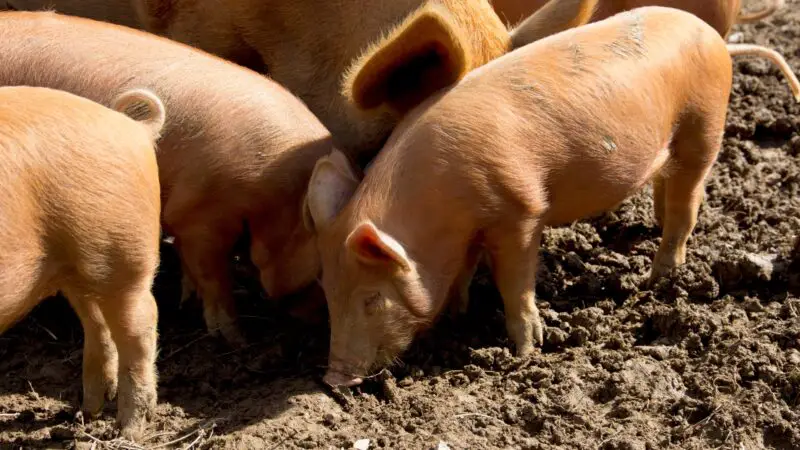
The Tamworth pig originated from Ireland, where they were nicknamed “The Irish Grazer” due to their excellent foraging abilities. In 1812, a man named Robert Peel imported some of the pigs and started breeding them on his estate located at Tamworth, England, hence their name. In 1865, the breed was given a distinct classification at the English Royal Show.
English authorities claim that the pig was extensively bred in several midland counties of England as it received major improvements in Staffordshire, Leicester, Northhampton, and Warwick. In 1882, the first Tamworths were introduced in the United States by Thomas Bennett of Rossville, Illinois.
Tamworths were mainly kept in dense forests and woods of beech and oak trees. However, breeding stocks declined significantly after World War II, and in the 1970s, only 17 pigs remained. Fortunately, in the 70s to 90s, the boars were imported from Australia to further ensure the breed’s survival.
Today, although there is little change in the population of Tamworths, there are still existing bloodlines that are kept by breeders for conservation.
Where Do Tamworth Pigs Originate?
Tamworth pigs originate in Ireland. They were then imported into the village of Tamworth, Staffordshire, but they were also bred in the counties of Warwick, Northampton, and Leicester.
Are Tamworth Pigs Rare?
Tamworth pigs are rare. There are only a few breeding stocks left. The Tamworth pig is listed by the Rare Breeds Survival Trust as a priority, which entails it has the highest level of concern in the organization.
What Do Tamworth Pigs Look Like?
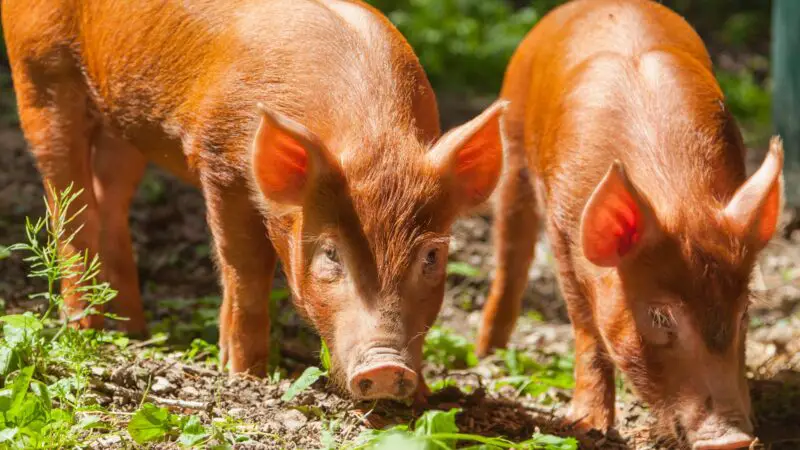
Medium-sized pigs with a slightly dished profile, long snouts and legs, firm and trim jowls, narrow backs, deep sides, curled tails, and prick ears. They’re fine, long, and straight coat is a red, red-gold, or ginger color. They have flesh-colored skin and may have large black spots, although this is considered undesirable.
How Long Does a Tamworth Pig Live?
A Tamworth pig can live 15 to 20 years. However, many owners claim that they expect shorter life expectancies. This may be due to several factors such as environment and level of care.
What Do Tamworth Pigs Eat?
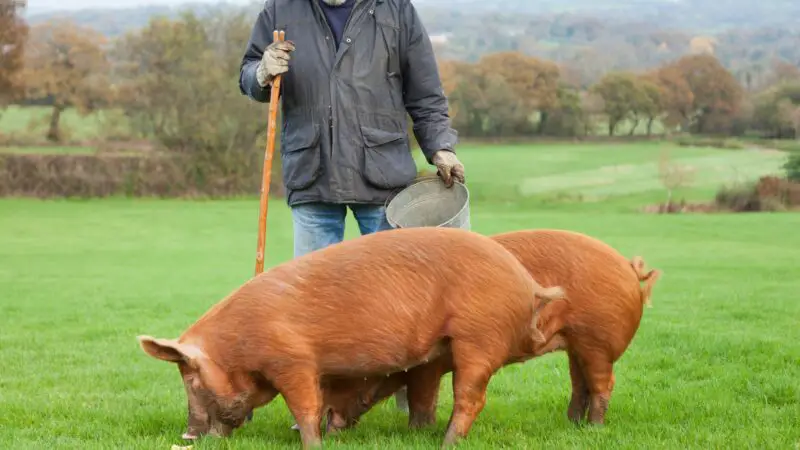
Tamworth pigs are opportunistic omnivores, which means they eat plant matter they forage for in pastures but may also consume invertebrates such as insects and worms. When being kept on farms, they are fed with energy feeds, consisting mainly of grains such as corn, barley, wheat, or oat, and protein feeds such as soybean meal, alfalfa meal, whey, or fish meal.
How Big Do Tamworth Pigs Grow?
Tamworth pigs have a length ranging from 39 to 55 inches and a height of 20 to 26 inches.
Are Tamworth Pigs a Heavy Breed?
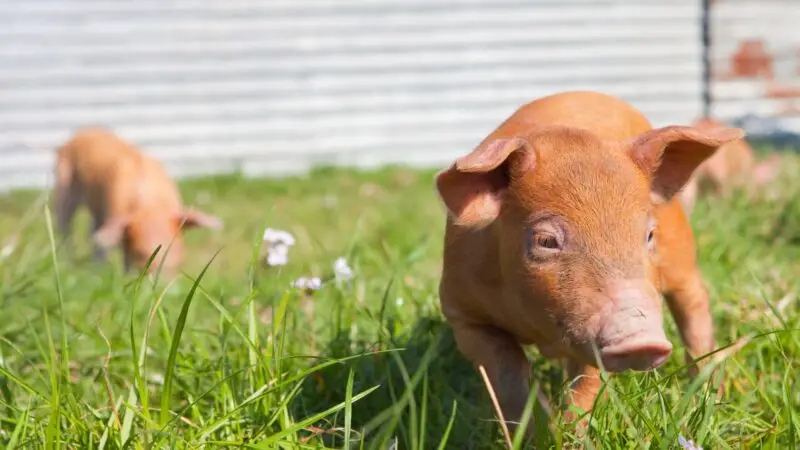
They are of average weight, with boars weighing around 535 to 800 pounds and sows weighing around 450 to 650 pounds.
What Are the Distinct Characteristics of a Tamworth Pig?
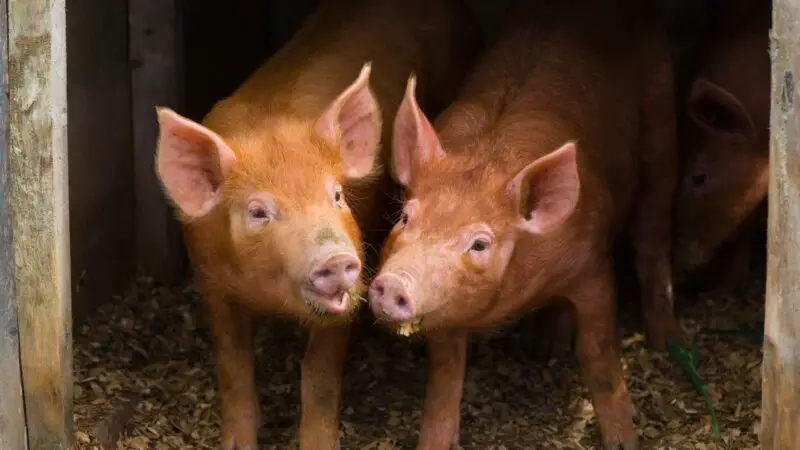
These pigs reflect centuries of natural selection for outdoor living as they are expected to find and forage for their food, especially acorns or mast found in oak and beech forests. Their long heads and snout make them excellent foragers, while their strong legs and excellent foot structure allow them to walk for considerably far distances.
Additionally, Tamworths are adaptable to a wide variety of climates due to their coats, which also protect them from sunburn. Sows are known to be prolific breeders and piglets often have a 100% survivability rate.
Tamworth Pig Temperament
Tamworth pigs are known to be docile but are still considered a very active breed. They require strong fencing to keep them contained in their respective homes. They are also intelligent and have a gentle disposition as they love human contact, making them easy to handle pigs.
Are Tamworth Pigs Good for Meat?
Tamworth pigs are good meat, they are traditionally a bacon breed, which means they mainly eat and thrive on low-energy feed but grow slowly. They can produce lean, fine-grained bacon and meat. Tamworths also have a 70% carcass yield due to their excellent meat-to-bone ratio.
How Much Does a Tamworth Pig Cost?
They can cost somewhere around $200 to $850, depending on age and sex.
Is Tamworth Pig a Heritage Breed?
Tamworth pig is a heritage breed, as they are thought to be descended from the oldest indigenous species of pigs, the Old English Forest Pig. Additionally, their bloodlines are hundreds of years old, having been discovered in the early 19th century.
Tamworth Pig Care Tips
Housing
Tamworth pigs require some form of shelter it can be as simple as a three-sided shelter with the fourth side being open so that the pigs have access to pasture. If you construct indoor housing, it may need fans and an attic for ventilation. There are also naturally ventilated shelters that have low roofs and manual openings.
Since pigs are natural excavators, place one strand of electric wire on the ground inside the pig pen to discourage them from digging under the fence. Do not put the wire directly across the pen entrance, as it will hurt the pigs.
Pasture System
Generally, pigs are destructive to pastures due to their rooting behavior. This is why a pasture management system must be in place. You can do so by selecting one of three ways:
- Permanent. This refers to pastures that have been seeded using perennial forage. It doesn’t require annual re-seeding but must still be reseeded based on the stocking rate and the owner’s needs.
- Temporary. These pastures are seeded using annual forage and do not grow back after their first growing season, which means they require owners to reseed on an annual basis. This system is the most convenient to owners, but stocking rates should be kept low.
- Rotation. This is the most commonly used system that allows crops to have a more consistent growing season wherein legumes and perennial grasses are placed in a rotation schedule with other grain crops. This system enables owners to take advantage of a wide variety of crops and will reduce weed, insect, and disease occurrence.
Nutrition
Pigs require easy access to readily available feed and water every day. Aside from forages, their diets consist of energy feeds, which usually consist of corn and other grains such as wheat, barley, oats, and triticale, and protein feeds (soybean meal, alfalfa meal, whey, plasma protein, fish field, field peas, etc.).
Human food waste or food that is no longer fit for human consumption can occasionally be fed to pigs in limited amounts. This includes dried bakery wastes, rejected fruits and vegetables, processed foods, and table scraps.
Feeders and Water
Feeding equipment should be able to prevent pigs from eating off the ground, where they can accidentally eat harmful microorganisms. Each pig needs 12 to 14 inches of feeder space. You can use ad-lib pan feeders, fence-line style troughs, or outdoor sled feeders.
For water, you can use a nipple drinker, mobile drinking unit, or pasture drinking unit to provide fresh and clean water for your pigs. Make sure that you regularly change the water. Feeders and waterers should be kept apart. This is why it’s best if the pigs’ housing is rectangular so that there is a considerable distance between drinking, feeding, and bedding areas.
Healthcare
Pigs are highly vulnerable to bacterial infections and soil-based parasites due to their rooting behavior. They are also susceptible to viral infections, including diseases that may be contracted by humans, such as the flu.
To treat and prevent diseases, conduct routine health exams with your local veterinarian and let them administer the appropriate medicine or vaccination. Other important health practices are castrating, tusk removal, teeth clipping, and deworming.
Breeding Tamworth Pigs
Below are three methods used in breeding pigs:
- Pen Mating. Usually utilized for smaller pig operations and refers to a method where owners allow the boars to run with females.
- Hand Mating. It is a supervised natural mating wherein boars are used to deliver semen to the sows and are assisted by an animal caretaker who monitors the entire event.
- Artificial Insemination. This method is commonly used by commercial pig producers and requires the collection of semen from the boars, which are then handled by professionals.
List of Sources
Pasture Management Systems for Swine: A Historical Perspective
